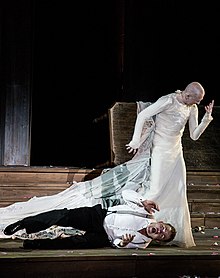Optical Atomic Clocks Are Ready to Redefine Time
A new way to keep time combines the precision and accuracy of optical atomic clocks with the reach and versatility of microwave signals.

SPECTRUM.IEEE.ORG
Optical Atomic Clocks Are Ready to Redefine Time
Researchers converted the precise timekeeping of optical atomic clocks
英語學習: freeze out
freeze out …をしめ出す; 〔米〕 …を寒さのため中止にする.
American lawmakers are proposing a bill to ban mainland Chinese from studying science and technology in the US.
New rules specify that no American tools can be used to make Huawei's products. Some of these products lack substitutes. Could this freeze out Huawei completely?
ECONOMIST.COM
America is determined to sink Huawei
The episode will have broader consequences for the tech industry
The 2020 Salzburger Festspiele | Salzburg Festival will take place in a "modified and shortened form". Due to coronavirus containment measures, the planned centenary programme of the festival will be reduced from 200 events over 44 days to around 90 small-scale performances over 30 days in August.

Salzburg Festival
Salzburger Festspiele

Jedermann, a play performed annually, in 2014
Genre
music
drama
Begins late July
Ends end of August
Frequency annual
Location(s) Salzburg, Austria
Inaugurated 1920; 100 years ago
The Salzburg Festival (German: Salzburger Festspiele) is a prominent festival of music and drama established in 1920. It is held each summer (for five weeks starting in late July) in the Austrian town of Salzburg, the birthplace of Wolfgang Amadeus Mozart. One highlight is the annual performance of the play Jedermann (Everyman) by Hugo von Hofmannsthal.
Since 1967, an annual Salzburg Easter Festival has also been held, organized by a separate organization.
Contents
1History
2Post World War II festivals
3In the 21st century
3.1Economy
4Salzburg Whitsun Festival
5See also
6References
7External links
國立故宮博物院 National Palace Museum
蒔繪收納盒
Japanese makie lacquer case
蒔繪是日本漆器工藝的一種,通常以黑漆為底,彩繪紋樣後再於其上撒金銀粉,最後加工研磨製造完成。十六世紀下半葉之後,蒔繪漆盒隨著國際貿易網路的開展而行銷歐亞世界。不管是不是直接受到明末鑑賞家的啟發,清朝康熙(1662-1722)、雍正(1723-1735)和乾隆(1736-1795)三位皇帝經常使用舶來品漆盒收存各式珍奇寶貝。展出的箱子,裝飾著日人稱為「蔦紋」的葉形圖案,裡面可以容納十九個木匣,最初是為了收納七十四件小瓷杯而設計,目前則留存其中的六十七件。
Makie stands for one of the techniques in Japanese lacquer craft. The base is usually coated in black lacquer, with the silver and gold powders sprinkled on top of the drawn patterns, and then completed by fine polishing. After the second half of the 16th century, the makie lacquer box traveled to Europe and across Asia with the development of international trading network. Regardless if the inspiration came directly from the connoisseurs in the late Ming dynasty, the Qing emperors Kangxi, Yongzheng, and Qianlong frequently collected their various treasures with these imported lacquer boxes. The exhibited box is decorated with the “tsuta” pattern named by the Japanese, and with the capacity of nineteen wooden cases. Initially the design was made to store 74 porcelain cups, and 67 pieces from the original set last till nowadays.
******************************
皇帝的多寶格
Curio Boxes of Qianlong Emperor
展期(Date):2019/12/25 ~ 2021/12/26
陳列室:南部院區 201
Gallery: (Southern Branch) 201
******************************


蒔絵(まきえ)は、漆工芸技法の一つである。
蒔繪(日語:蒔絵),是在漆器上以金、銀、色粉等材料所繪製而成的紋樣裝飾,為日本的傳統工藝技術。利用漆的黏性,將銀粉或金粉依照想要的圖樣,固定於漆器上的技法稱作蒔繪。「漆」指的是漆樹的汁液,塗抹於器具上,除了可以固定銀粉、金粉,也可以使器具更有光澤。蒔繪的紋樣題材眾多,技法則是隨著時代不斷改良、推陳出新。日本的國寶中有許多都是蒔繪的作品,如《八橋蒔繪螺鈿硯箱》、《片輪車蒔繪螺鈿手箱》等。由於日本在江戶時期或更早的年代,與許多歐洲國家有過貿易往來,在現在一些歐洲國家的博物館亦可見到日本蒔繪的蹤跡,如英國維多利亞和阿爾伯特博物館藏的《樓閣人物源氏物語蒔繪箱》,此件為17世紀日本實施鎖國時,由當時的荷蘭東印度公司向日本購買的作品。
目錄
1發展歷史
2題材種類[1]
2.1文學
2.2植物
2.3動物
2.4佛教
2.5其他類
3主要技法[2]
4其他技法[3]
4.1背景樣式
4.2線條表現
4.3彩色粉末
4.4貼片
5文化交流
5.1歐日交流[4]
5.2中日交流[5]
5.3台灣蒔繪
6參考資料
發展歷史[編輯]
日本最早有關蒔繪技術的藏品為正倉院的「金銀鈿荘唐大刀」,年代約在奈良時代末期。在這把唐大刀的刀鞘上可看見金色紋飾,稱作「末金鏤」。「末金鏤」一詞出自《東大寺獻物帳》(日文:東大寺獻物帳):「鞘上末金鏤作。」末金鏤與後來的研出蒔繪相似,且比「蒔繪」一詞早出現,被認為是日本蒔繪的前身。
在平安時代,由於金銀粉的精製技術尚未成熟,此時流行的蒔繪技法為「研出蒔繪」。先前介紹的「金銀鈿荘唐大刀」也屬於研出蒔繪的一種。研出蒔繪的作法為,先塗上一層漆,撒上金粉後,整片繪畫區域再塗一層漆,最後用木炭慢慢磨平表面顯露出金粉層。

漆器の板屏風に描かれた蒔絵の菊

蒔絵(拡大画像)

八橋蒔絵螺鈿手箱 尾形光琳作 国宝 東京国立博物館蔵
沒有留言:
張貼留言